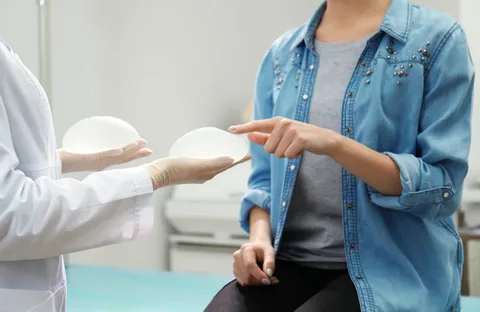There are variety of implant types: silicone gel-filled, saline-filled, silicone/saline combination, PVP-Hydrogel, and plant oil. There are round implants and anatomic implants. The anatomic type of implant may also be described as a teardrop or tapered implant. The rounded implant gives a fuller upper chest and cleavage. The tapered implant is sometimes suggested for thinner individuals because it may result in a more natural looking upper chest. The outer surface of the implant may be either textured or smooth. Although conclusive evidence does not exist, textured implants may help reduce the adverse effect of capsule formation around the implant.
There are also variations within the surgical procedures used to insert them. The relative value of implant types is debated amongst plastic surgeons and other medical authorities who study the possible adverse reactions to implants.
Breast implants have the same basic type of outer envelope made of a solid, rubber-like form of silicone called an elastomer. Implants come in many sizes; the size used depends on the amount of augmentation desired. The volume of the filling contained within the outer envelope may range from 200cc to 400cc, to even larger. A fluid ounce equals approximately 30cc.
Silicone gel-filled implants
These implants consist of an elastomer envelope pre-filled (before surgery) with a clear, sticky, thick jelly-like form of silicone that closely approximates the consistency of breast tissue. Before the 1992 FDA ruling that virtually banned the use of silicone implants because of serious questions about patients’ health, this was the most common type of implant used. Much of the controversy surrounding implants is related to the possible adverse effects when the silicone gel leaks, bleeds, or ruptures through the elastomer envelope.
Silicone gel-filled implants, contrary to what many believe, were not taken off the U.S. market. These implants were reclassified at the time of the implant controversy, and now are only available (in the U.S.) in an FDA approved study of gel implants under the care of an approved investigator. There are relatively few surgeons in the country who have been authorized as an investigator in this FDA study. Individuals seeking first time breast enlargement do not qualify for the study. There is no reduction in cost for those who participate in the study.
Silicone gel-filled implants are still readily available and regularly used by plastic and gender-reassignment surgeons throughout the world.
Saline-filled implants
These implants contain saline, a sterile salt water. The implant is surgically inserted while empty and is filled after it is put in place, which allows for some adjustment in size. According to some, the major drawback of saline implants is that they do not feel or look as natural as gel implants. This is especially true in those who don’t have much breast tissue to cover the implant. Some women say the implant tends to wrinkle or ripple under the skin, and that the breast doesn’t move or hang naturally. In addition, many plastic surgeons believe that saline implants tend to have a higher rate of leaking and deflation than silicone gel implants, which means more frequent surgery to replace them.
On the other hand, if the saline does leak into the body, it is similar to other body fluids and is absorbed without harm. Also, a smaller incision is needed because the implant is inserted in a deflated state and filled with saline after insertion.
Plant Oil-filled implants
Plant oil-filled implants have developed from the concern over health safety issues relative to the silicone gel-filled implant. These breast implants filled with a natural vegetable oil promised greater safety for women. They are available throughout the European Union but are still undergoing clinical trials in the US and Canada. The new implant, called Trilucent, contains triglyceride, an oil that has been used for 40 years as a nutrient in intravenous feeding and as a drug carrier in injections. The manufacturers of Trilucent indicate like saline, the vegetable oil can be metabolized and excreted by the body, but it is also resistant to bacterial and fungal contamination whereas saline is not. Its lubricating properties means that it should not rub the inside surface of the implant; this has been linked to leakages in conventional implants.
However, the Medical Devices Agency of the United Kingdom, on June 06, 2000, recommended that women with Trilucent breast implants, should have them removed because of health concerns. The government stressed this was a precautionary measure and there was no evidence of any serious medical problems. But tests have shown that material produced if the oil breaks down in the body could potentially cause cancer or damage to a fetus.
PVP-Hydrogel-filled implants
The biocompatible polyvinylpyrrolidone (PVP) has a history of been used as a binding agent for tablets and as a carrier in topical applications. The water-soluble, PVP-Hydrogel has been designed to be safely excreted through the kidneys in the event of traumatic rupture. It will not be metabolized by the body. The implant manufacturer suggests improved radiolucency over silicone gel-filled or saline-filled implants, which may allow more clear visualization of the tissue during mammography.
Double lumen implants
These implants consist of two lumens, or envelopes, one inside the other. In some models, the inner envelope is pre-filled with silicone gel, and the outer envelope is filled with saline at the time of surgery. In other models, the relationship is reversed and the inner envelope is filled with saline. Some studies suggest that the double-walled model results in a softer, more natural appearance because it reduces the incidence of capsular contracture.
Coated implants
The coated implant was meant to be an improvement over the standard silicone implant, which has a smooth outer surface. The foam coating was thought to reduce incidence of capsular contracture because the texture encouraged the body tissue to grow into it. However, the foam, which was originally used in furniture upholstery, oil filters, and carburetors, was found to increase risk of infection, fragment in the body, and chemically break down and release small amounts of a substance called 2-toluenediamine (TDA), which can cause cancer in animals. These implants are no longer available.
However, many of today’s implants have textured surfaces which are designed to reduce capsular contracture. Since no foam is involved they do not pose the potential risks of the foam-coated models.
Source: Transgender Care
 Lesbian, Gay, Bisexual, Transgender & Intersex News Lesbian News, Gay News, Bisexual News, Transgender News, Intersex News, LGBTI News
Lesbian, Gay, Bisexual, Transgender & Intersex News Lesbian News, Gay News, Bisexual News, Transgender News, Intersex News, LGBTI News




